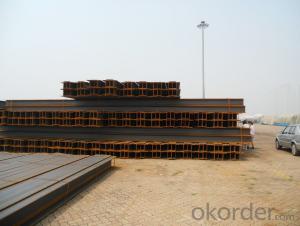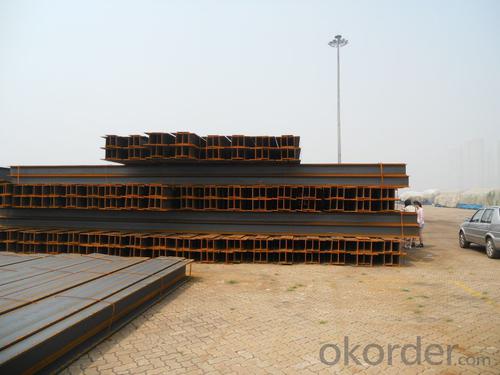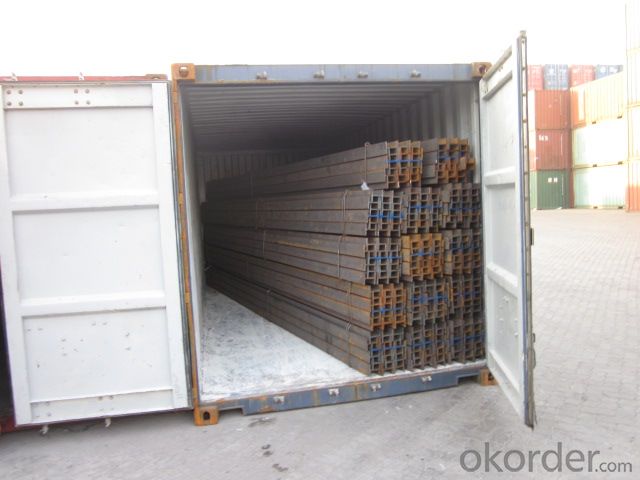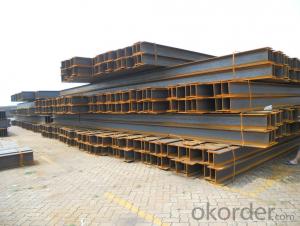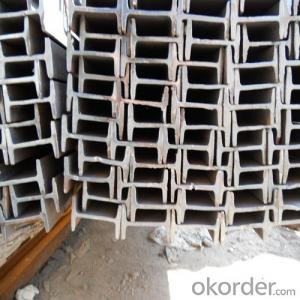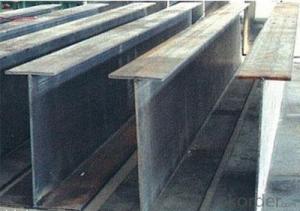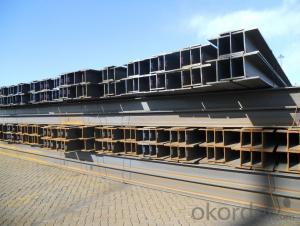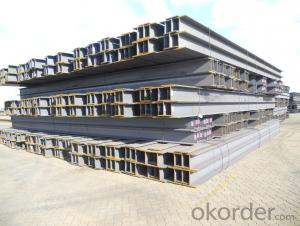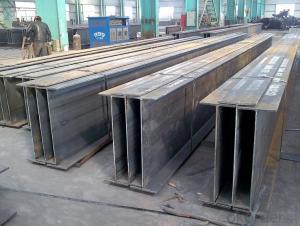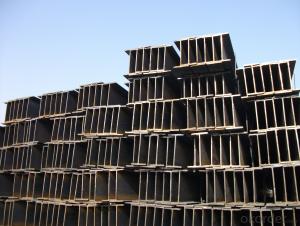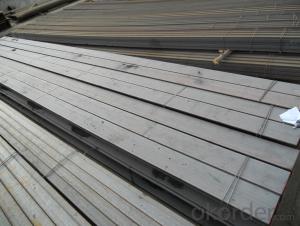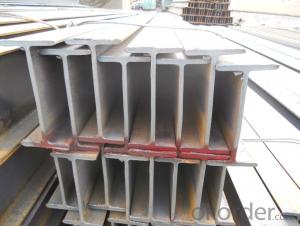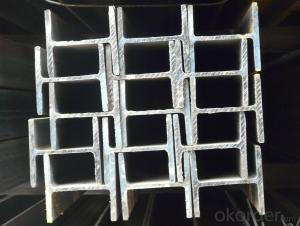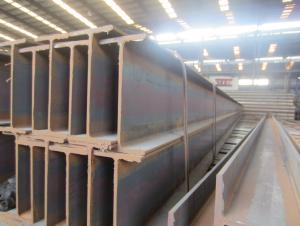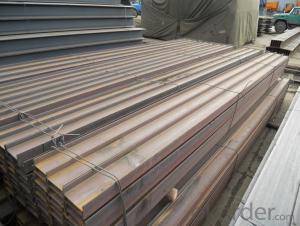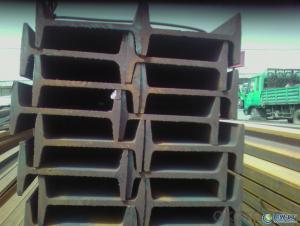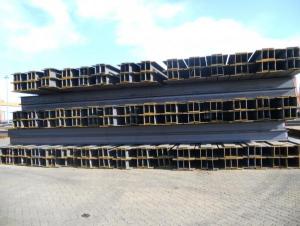JIS Standard SS400 H beams with High Quality 428mm-500mm
- Loading Port:
- China main port
- Payment Terms:
- TT or LC
- Min Order Qty:
- 100 m.t
- Supply Capability:
- 15000 m.t/month
OKorder Service Pledge
OKorder Financial Service
You Might Also Like
Specifications of JIS Standard SS400 H beams with High Quality 428mm-500mm:
1. Standard: JIS 3192
2. Grade: SS400 or Equivalent
3. Length: 10m, 12m as following table
4. Invoicing on theoretical weight or actual weight as customer request
5.Payment: TT or L/C
Size and Mass of JIS Standard SS400 H beams with High Quality 428mm-500mm:
| Size (mm) | Mass (Kg/m) | Size (mm) | Mass (Kg) |
| 428*407*20.0 | 283 | 450*200*9.0 | 74.9 |
| 458*417*30.0 | 415 | 500*200*10.0 | 88.2 |
Packaging & Delivery of JIS Standard SS400 H beams with High Quality 428mm-500mm for Building Structures:
1. Packing: it is nude packed in bundles by steel wire rod
2. Bundle weight: not more than 3.5MT for bulk vessel; less than 3 MT for container load
3. Marks:
Color marking: There will be color marking on both end of the bundle for the cargo delivered by bulk vessel. That makes it easily to distinguish at the destination port.
Tag mark: there will be tag mark tied up on the bundles. The information usually including supplier logo and name, product name, made in China, shipping marks and other information request by the customer.
If loading by container the marking is not needed, but we will prepare it as customer request.
4. Transportation: the goods are delivered by truck from mill to loading port, the maximum quantity can be loaded is around 40MTs by each truck. If the order quantity cannot reach the full truck loaded, the transportation cost per ton will be little higher than full load.
5. Delivered by container or bulk vessel
FAQ:
Q1: Why buy Materials & Equipment from OKorder.com?
A1: All products offered by OKorder.com are carefully selected from China's most reliable manufacturing enterprises. Through its ISO certifications, OKorder.com adheres to the highest standards and a commitment to supply chain safety and customer satisfaction.
Q2: How do we guarantee the quality of our products?
A2: We have established an advanced quality management system which conducts strict quality tests at every step, from raw materials to the final product. At the same time, we provide extensive follow-up service assurances as required.
Q3: How soon can we receive the product after purchase?
A3: Within three days of placing an order, we will arrange production. The shipping date is dependent upon the quatity, how many sizes you want and the plan of production, but is typically 1 month to 2 months days from the beginning of production.
Images of JIS Standard SS400 H beams with High Quality 428mm-500mm:
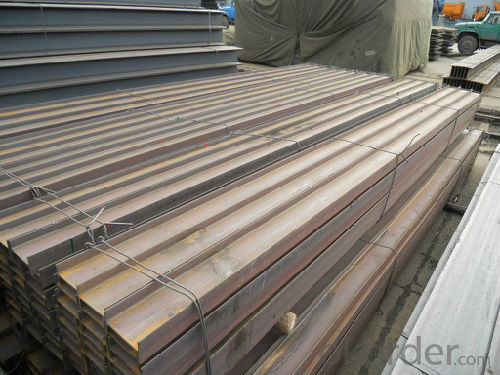
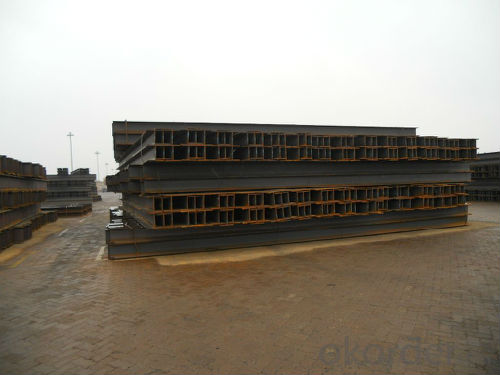
* If you would like to get our price, please inform us the size, standard/material and quantity. Thank you very much for your attention.
- Q: What are the common design considerations for steel H-beams in roofing applications?
- Some common design considerations for steel H-beams in roofing applications include the beam's load-carrying capacity, span length, deflection limits, and overall structural stability. Additionally, factors such as the weight of the roofing material, wind loads, and potential snow accumulation need to be taken into account. The design should also consider the potential for thermal expansion and contraction, as well as the need for proper drainage to prevent water accumulation.
- Q: Are steel H-beams suitable for use in the construction of correctional facilities or prisons?
- Yes, steel H-beams are suitable for use in the construction of correctional facilities or prisons. They provide superior strength and durability, which is crucial for the security and safety requirements of such facilities. Steel H-beams are capable of supporting heavy loads, providing structural stability, and withstanding extreme weather conditions, making them an ideal choice for prison construction projects.
- Q: What is the typical lifespan of steel H-beams?
- The typical lifespan of steel H-beams can vary depending on several factors such as the environment in which they are used, the quality of the steel, and the level of maintenance they receive. However, under normal conditions, steel H-beams are known for their durability and longevity. When properly designed, installed, and maintained, steel H-beams can have a lifespan of several decades or even longer. In many cases, they can last well over 50 years. This makes them a popular choice for structural applications in various industries, including construction, bridges, and infrastructure. To ensure the longevity of steel H-beams, it is essential to protect them from environmental factors that can accelerate corrosion, such as exposure to moisture, saltwater, chemicals, or extreme temperatures. Regular inspection and maintenance, including cleaning, repainting, and addressing any signs of damage or deterioration, can significantly extend their lifespan. It is important to note that the lifespan of steel H-beams can also be influenced by factors such as load capacity, stress levels, and the overall structural design. Therefore, it is crucial to consult with structural engineers and adhere to industry standards and guidelines to maximize their longevity. Overall, while the exact lifespan of steel H-beams may vary depending on specific circumstances, they are generally designed to provide reliable structural support for many years, making them a durable and long-lasting choice for various construction and infrastructure projects.
- Q: What are the common sizes of steel H-beams used in residential construction?
- The common sizes of steel H-beams used in residential construction range from 4 inches to 12 inches in height, with varying widths depending on the specific structural requirements of the project.
- Q: What is the lifespan of a steel H-beam in outdoor applications?
- The lifespan of a steel H-beam in outdoor applications can vary depending on several factors. Firstly, the quality and grade of the steel used in the H-beam will play a significant role in determining its lifespan. Higher quality steels with proper corrosion-resistant coatings can withstand outdoor conditions for a longer period. Secondly, environmental conditions such as exposure to moisture, extreme temperatures, and corrosive elements like saltwater or chemicals can impact the lifespan of the H-beam. Regular maintenance and proper protective measures, such as applying anti-corrosion coatings or galvanization, can significantly extend the lifespan of the H-beam in such environments. Additionally, the load-bearing capacity and structural integrity of the H-beam should be considered to ensure it can withstand any potential stress or external forces it may encounter during its lifespan. Proper design, installation, and regular inspections are crucial to maintaining the structural integrity and longevity of the H-beam in outdoor applications. Overall, it is challenging to provide a specific lifespan for a steel H-beam in outdoor applications, as it depends on various factors as mentioned above. However, with proper material selection, regular maintenance, and protective measures, a steel H-beam can last for several decades in outdoor applications.
- Q: What are the different installation methods for steel H-beams?
- Steel H-beams can be installed using various methods depending on the specific application and structural needs. Some commonly used techniques include: 1. Welding: The most prevalent method involves welding the beam to the supporting structure or connecting it to other beams or columns. Skilled labor and proper welding procedures are necessary to ensure structural integrity. 2. Bolting: Another popular approach is to connect the H-beam to the supporting structure or other beams using bolts and nuts. This method allows for easy disassembly and reassembly, making it suitable for temporary structures or situations requiring modifications. Maintaining structural stability requires proper bolt size, torque, and alignment. 3. Grouting: Sometimes, H-beams are embedded in concrete structures for added strength and stability. Grouting involves filling the space between the beam and the concrete with a high-strength, non-shrink grout to create a solid connection. This method is commonly used in construction projects with high load-bearing requirements. 4. Crane or hoist installation: When the H-beam is too heavy or large to install manually, a crane or hoist can be utilized. This method involves lifting the beam into position and securing it using welding or bolting techniques. Proper lifting and rigging procedures must be followed to ensure safety and prevent damage to the beam or surrounding structures. 5. Pre-engineered systems: Some manufacturers offer pre-engineered systems for steel H-beam installation. These systems include pre-cut and pre-drilled beams, along with detailed assembly instructions. This simplifies the installation process and ensures accurate alignment and connection of the beams. To determine the most suitable installation method for steel H-beams, it is crucial to consult with a structural engineer or construction professional who can assess the specific project requirements and local building codes.
- Q: Can steel H-beams be customized to specific lengths?
- Yes, steel H-beams can be customized to specific lengths. The length of steel H-beams can be altered during the manufacturing process to meet the specific requirements of construction projects.
- Q: How do steel H-beams contribute to energy-efficient buildings?
- Due to their unique structural properties and sustainability benefits, steel H-beams play a vital role in the construction of energy-efficient buildings. Firstly, H-beams are renowned for their outstanding strength-to-weight ratio, enabling the creation of large, open spaces without excessive structural support. This characteristic allows architects to design buildings with ample natural light and improved airflow, reducing the need for artificial lighting and ventilation systems and ultimately decreasing energy usage. Furthermore, steel H-beams can be fabricated to precise dimensions, ensuring accurate assembly and minimizing waste during construction. This not only saves resources but also reduces the energy required for manufacturing and transporting materials. Moreover, steel is highly recyclable, making H-beams an environmentally friendly choice for construction. The recycling process consumes significantly less energy compared to producing new steel, leading to reduced greenhouse gas emissions and the conservation of natural resources. Apart from their structural advantages, steel H-beams also contribute to energy efficiency through their thermal properties. Steel is an excellent conductor of heat, facilitating efficient transfer and distribution of thermal energy within a building. This feature enables better insulation and temperature control, thereby reducing reliance on heating and cooling systems and consequently decreasing energy consumption. Another benefit of steel H-beams is their durability and resistance to environmental factors such as fire, earthquakes, and pests. This durability ensures the longevity of energy-efficient buildings, reducing the need for frequent repairs and replacements, which in turn saves energy and resources. In conclusion, steel H-beams provide a robust, lightweight, and sustainable structural solution for energy-efficient buildings. Their ability to create open and spacious designs, accurate fabrication, thermal efficiency, and durability all contribute to the reduction of energy consumption and the promotion of sustainability in construction.
- Q: How can the steel posts of different types of H steel be butted?
- When bolted and welded composite joints are used, the web shall be bolted and the flanges shall be single plate, V - shaped, bevel, and weld
- Q: Can steel H-beams be used for warehouse construction?
- Indeed, warehouse construction can make use of steel H-beams. These H-beams, also referred to as I-beams or W-beams, are extensively employed in the construction sector owing to their robustness and resilience. They are especially well-suited for warehouse construction as they offer structural reinforcement and are capable of bearing significant loads. With their ability to evenly distribute weight, steel H-beams are perfectly suited for bolstering the roof and walls of a warehouse, thereby ensuring its stability. Moreover, the ease with which steel H-beams can be fabricated and installed has made them highly favored within the construction industry.
Send your message to us
JIS Standard SS400 H beams with High Quality 428mm-500mm
- Loading Port:
- China main port
- Payment Terms:
- TT or LC
- Min Order Qty:
- 100 m.t
- Supply Capability:
- 15000 m.t/month
OKorder Service Pledge
OKorder Financial Service
Similar products
Hot products
Hot Searches
Related keywords
